History

Auricht Family at Langmeil
The history of Langmeil is deeply entwined in stories about a brave pioneer, a timeless vineyard, industry downfall, three white knights and a present-day family’s enduring legacy.
Follow our timeline to discover some of the most notable moments and milestones from Langmeil’s contributions to Australia’s remarkable wine history:

Selwin Auricht feeding
the horses
1842
Pioneer, Christian Auricht, establishes one of the Barossa’s first trading villages on the banks of the North Para River, naming it Langmeil. This historical site is home to Langmeil Winery today.
Auricht had migrated from Prussia in 1838 seeking religious freedom for his family in the new world.
A blacksmith by trade, and just 36 years old, this was Auricht and his family’s fifth move in seven years - from Klastawe to Turowo in 1837; to Hamburg in 1838; to South Australia and Glen Osmond in 1839; to Klemzig in 1840, then finally to Langmeil - their home for the remainder of their lives.
Auricht’s legacy survives today in the Freedom vineyard believed planted as part of his mixed farm in 1843, now believed to be the oldest surviving Shiraz vineyard in the world.

The Freedom Shiraz
Vineyard
1843
Auricht establishes a smithy and begins tending a mixed farm. In the years that followed, a bakery, cobbler's shop and butcher's shop were built, including a well, which became the trading centre of the village.
The main roadway to the northern copper mining townships of Kapunda and Burra passed by the village with many travellers stopping to water their horses and gather provisions before continuing their long journey.
Christian also planted one-acre of Shiraz vines on the estate, which is still producing fruit today. Today, Auricht's old vineyard is the source of Langmeil’s icon wine, The Freedom 1843 Shiraz. This rare wine commemorates the pioneering spirit of the region’s first settlers and their willingness to endure hardship for the right to keep their faith and their freedom.

World War I
1914 to 1918
1916
The Nomenclature Act - Prior to World War I, many Australian places had German names. Because of the ongoing war against Germany and subsequent anti-German sentiment, many place names with German origins were changed. This was done in August 1916 through petitions and Acts of Parliament.
The village of Langmeil was then changed to Bilyara and today it is now known as the township of Tanunda.

Arthur Hanisch
1932
Theodor Hanisch established the first winery on the property in 1932, operating under the name Paradale. He was the youngest son of Eleonore Auricht, the second daughter of Christian Auricht. Theodor’s son, Arthur, later managed the operation.
Theodor died in 1968 and Arthur passed just a year later in 1969.

Bernkastel label
1972
After Arthur Hanisch's death in 1969, the family sold the property.
In 1972 Bernkastel Wines purchased the winery and property, operating under their own label.
The 1980s proved hard years for the Australian wine industry. Export sales amounted to less than 20% of total production and the industry was faced with a seemingly never-ending over-supply of grapes. The South Australian Government introduced a vine pull scheme whereby growers were paid to remove unwanted vines.
Both growers and winemakers were affected, and Bernkastel Wines went into liquidation in 1988. Bought at a liquidation sale, the new owners did not operate the winery but did use the cellar door to sell bin end stocks.
The doors closed in August 1993 and the property and vineyards lay idle until 1996.

Richard Lindner, Carl Lindner
and Chris Bitter
1996
Three white knights, better known around the Barossa as three local mates, collaborate to purchase the derelict property.
Richard Lindner, Carl Lindner and Chris Bitter, whose families have lived in the Barossa for several generations, restored the old buildings, well and landscaped the grounds. The trio refurbished the old winery and named it Langmeil after the original 1842 village.
In the clean-up prior to restoration, a small patch of gnarly old shiraz vines from Auricht’s 1843 planting was discovered.
The most important task was to rescue them, and after several months of tender loving care, the vineyard was successfully revived and named The Freedom. After careful viticulture, Langmeil's first harvest from the Freedom vineyard was in 1997.

Jonathan Bitter and
Arthur Jackaman
1998
The winery purchased their Lyndoch property known as Jackamans, after Arthur Jackaman the previous owner.
This is home to old vine cabernet, grenache and shiraz. In the southern part of the Barossa known for its rich red and iron stone rich soils.

Freedom 1843 vine by
Dragan Radocaj
1999
The first release of Langmeil’s the Freedom 1843 shiraz – 1997 vintage. This marks the first year a single vineyard wine dedicated to what is believed to be the oldest surviving shiraz vineyard in the world was released.
The most important task was to rescue them, and after several months of tender loving care, the vineyard was successfully revived and named Freedom. After careful gardening, Langmeil's first harvest from the Freedom vineyard was in 1997.

The Lindner Family
in 2011
2011
Richard and Shirley Lindner purchase Langmeil Winery outright with their sons, Paul (Chief Winemaker) and James (Sales and Marketing), ensuring Langmeil remains family-owned for generations to come.
Restoration of the trading village and grounds enters its final phase, with sights set firmly on converting the old cobbler’s store into a specialised underground tasting room, the barn into a long table entertaining room and the old winery residence into a stylish, comfortable guest retreat.
By now Langmeil’s winemaking is internationally recognised and it is regarded as one of the Barossa’s premium wine producers, attracting visitors from all corners of the globe to visit cellar door and the restored village grounds.

Langmeil's Eden Valley
Vineyard
2012
Langmeil becomes custodian of an historic Eden Valley vineyard. This vineyard is home to the Pure Eden Shiraz vineyard believed to be planted by Charles Angas in the 1890’s. It is also home to our single vineyard old vine Wattle Brae Riesling and High Road chardonnay.
This vineyard represents Langmeil’s commitment to making wines that express and embrace the unique characteristics of the Barossa high country.

The Freedom 1843
Shiraz
2014
The Freedom 1843 Shiraz joins the prestigious Langton’s Classification VI honour roll in the ‘Excellent’ category of, and is lauded by James Halliday as a wine which “…you should kneel in the presence of…”.

Langtons
2018
The Freedom 1843 Shiraz is re-classified in the prestigious Langton’s Classification VII honour roll in the ‘Outstanding’ category which describes "The best of Australian winemaking practices, vineyard provenance and regional voice."

The Freedom Cellar
Today
Once a derelict winery built amongst an abandoned trading village of a bygone era, Langmeil Winery is now a revived and captivating pocket of Barossa’s vine and wine history.
The Freedom Cellar, which was originally the Cobbler's shop in the historic trading village, has opened its doors. Lovingly restored using time-honored artisan carpentry and masonry skills, the cellar is now the ultimate location in which to sample Langmeil’s Old Vine Garden wines as part of an intimately hosted winery and historic vineyard experience.
Ein Prosit! (Cheers!)

The Langmeil Family 2016
Back row from L to R - Paul, Natalie, William, Georgie and James
Front row - Mackenzie, Shirley, Richard, Bridget, Mia
